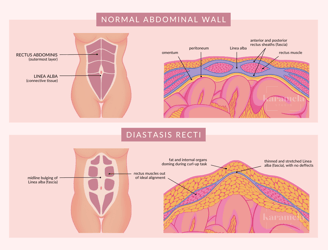Understanding Diastasis Recti
Understanding, Treating, and Strengthening
Karamela Studio
11/8/20232 min read


What is Diastasis Recti ?
Diastasis recti, commonly referred to as "abdominal separation," is a condition that occurs when the connective tissue (linea alba) between the rectus abdominis muscles (commonly known as the "six-pack" muscles) becomes stretched and weakened. This separation allows the abdominal organs to protrude, creating a noticeable bulge in the midsection.
Who is likely to get Diastasis Recti ?
Diastasis recti is most commonly experienced by pregnant women due to the pressure exerted by the growing uterus on the abdominal wall. However, it can also occur in other situations, such as rapid weight gain or intense abdominal exercises performed incorrectly.
Can Diastasis Recti be harmful ?
While diastasis recti is not necessarily harmful on its own, it can lead to a variety of issues, including lower back pain, poor posture, and pelvic floor dysfunction. In severe cases, it may also contribute to hernias.
Diastasis Recti treatment
Pregnancy and postpartum corrective exercise specialists, physical therapists, or healthcare professionals can provide guidance on exercises and techniques to help strengthen the abdominal muscles and reduce the separation. In some cases, surgical intervention may be necessary to repair severe diastasis recti.
How to measure Diastasis Recti ?
Lie flat on your back with your knees bent
Find a comfortable surface to lie on, like a yoga mat or a carpeted floor.
Place your fingers on your belly button, pointing towards your pelvis, and press down
Use your index and middle fingers for this step.
Lift your head up about an inch while keeping your shoulders on the ground
Engage your abdominal muscles slightly as you lift your head. Avoid straining your neck or upper back.
Feel for a gap between the muscles
While maintaining the head lift, feel along the midline of your abdomen, above and below your belly button. You're checking for any separation or gap between the muscles.
Measure the gap
If you have diastasis recti, you will feel a gap between the muscles that is an inch wide (~ 2 fingers) or greater. Take note of the width of the separation.
Remember, every person's situation is unique, so seeking personalized advice and support is crucial. If you suspect you have diastasis recti, it's recommended to consult a healthcare professional for an accurate assessment and appropriate treatment plan.
PLEASE NOTE: The content provided in this article is not a substitute for professional medical advice and should not be employed for self-diagnosis or self-treatment.
